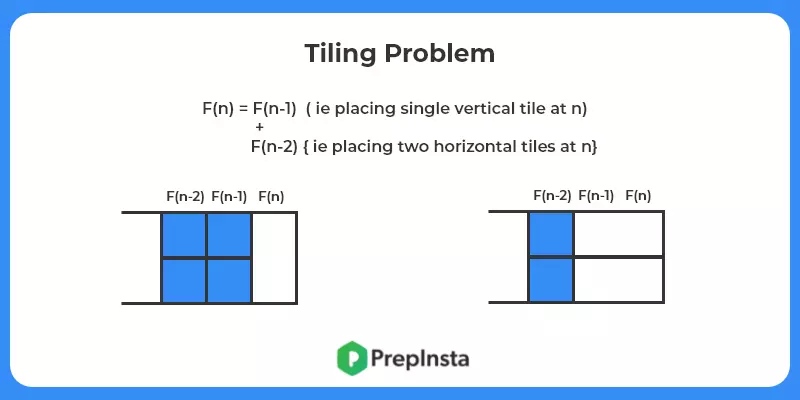Tiling Problem
Tiling Problem
In the tiling problem, we have to find the number of ways to fill a board. The problem has a similar solution as the Fibonacci number using dynamic programming. In this article, we have a C++ solution with an explanation.

Tiling Problem Description
We are given a land of 2*n. We are given infinite supply of 2*1 tiles. We can place these tiles either horizontally or vertically. Find the number of ways to cover the land.
Input:
- First line contains integer n – The width of land.
Output:
- Required number of ways
Tiling Problem Solution Explanation
Hint – This problem has similar solution used to find nth Fibonacci number using dynamic programming.
Solution (Top Down):
To build a top down solution we must follow the following steps –
- Break Down the Problem –Let’s suppose we have a function F(x) that outputs number of ways to fill a land of 2*x dimension. Then –
F(x) = F(x-1) + F(x-2)
ie Place a vertical tile at nth Position + Place vertical tile at (n-1)th position.
- Find the base case – Base case is the solution of smallest known problem. In this problem we know that F(1) = 1 (We can have only 1 file in vertical orientation) & F(2) = 2 { 2 tiles in vertical orientation or 2 tiles in horizontal orientation}.
- Check for optimal substructure and overlapping sub problems – It is easy to see that the problem can be broken down into smaller problems. {Same as Fibonacci numbers}.
Time & Space Complexity – O(n)

Code
Output
3
3
Bottom up Solution
Here we create a dp array of length n+1. And use similar transition as above.
Time & Space Complexity – O(n)
Code
Output
3
3



Login/Signup to comment